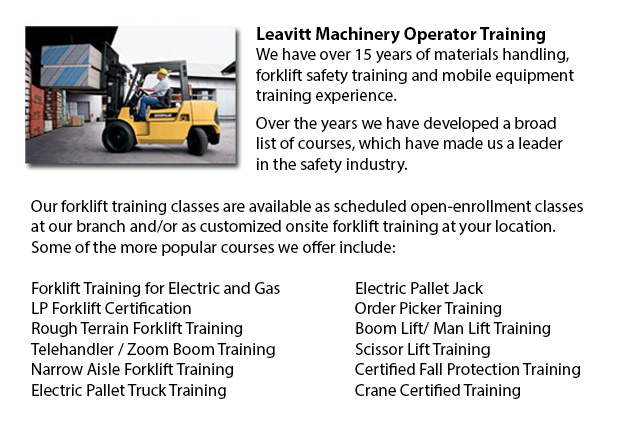
Prince Albert Forklift Training Schools - Why Forklift Training Schools Are Vital To Your Business
If you are looking for a job as an operator of a forklift, our regulatory-compliant forklift training Schools offer exceptional instruction in numerous types and styles of forklifts, lessons on pre-shift inspection, fuel kinds and dealing with fuels, and safe use of a lift truck. Practical, hands-on training assists those participating in obtaining basic operational skills. Program content covers current regulations governing the utilization of lift trucks. Our proven forklift courses are designed to offer training on these kinds of trucks: narrow isle forklift, counterbalanced forklift and powered pallet truck.
Whilst the lift truck is in use, do not raise or lower the forks. Loads must not extend higher than the backrest. This is because of the danger of the load sliding back towards the operator. Inspect for overhead obstructions and make sure there is enough clearance prior to raising a load. Stay away from overhead power lines. Once the load is raised straight up, tilt it back slightly.
While the load is raised the lift truck will be less stable. Make certain that no pedestrians cross beneath the elevated fork. The operator must not leave the forklift when the load is raised.
The forks must be level when handling pallets, and high enough to extend all the way into and beneath the load. The width of the forks should provide equal distribution of weight.
Set the brakes and chock the wheels before loading and unloading the truck. The floors must be strong enough to support the combined weight of the forklift and its load. Fixed jacks can be installed in order to support a semi-trailer that is not attached to a tractor. The height of the entrance door should clear the forklift height by at least 5 cm. Mark edges of docks, rail cars or ramps and avoid them.
-
Prince Albert Forklift Training Courses
Prince Albert Forklift Training Courses - When forklift operator safety training is tailored for illiteracy, training time is lessened by 50 percent. Lift-truck operator driver safety training evaluation, train the trainer and forklift training certi... More -
Prince Albert Heavy Equipment Training
Prince Albert Heavy Equipment Training - The two most common kinds of heavy equipment training are classed into the categories of equipment; equipment which is fashioned with rubber tires or those with tracks. The tracked vehicle are heavy duty machi... More -
Prince Albert Order Picker License
Prince Albert Order Picker License - Order preparation operation or order picking as it is more usually known is a method utilized within warehouse operations and comprises staff called order pickers. The order picker's duty is to take and collect ar... More -
Operator Safety Training, Re-Qualification Training, In-House Instructor Training in Prince Albert
Used in nearly all warehouse operations, boat yards or industrial construction sites, the lift truck is a very important part to be able to help raise and transfer cargo. The reach feature of a lift truck can help improve the applications which the f... More -
Prince Albert Overhead Crane Certification
Prince Albert Overhead Crane Certification - The overhead crane training certification program is designed to be effective with all those participating regardless of language or literacy restrictions. The course has two parts: a practical training se... More -
Prince Albert Heavy Equipment Training Programs
Prince Albert Heavy Equipment Training Programs - There are different types of equipment that are ready to be utilized at any given time on a construction site. These equipment require mechanics to be able to complete the maintenance tasks, operators... More -
Prince Albert Crane Operator Certification
Prince Albert Crane Operator Certification - The process to allow individuals to operate specific kinds of cranes is to take crane operator certification training to be given certification. The certification process consists of classroom learning, ha... More -
Prince Albert Crane Safety Training
Prince Albert Crane Safety Training - Both crane driver as well as their employers should know all the possible issues associated to the use of an overhead crane. All over North America, there is legislation that provides regulation for the safe oper... More

Forklift Certification Prince Albert
TOLL FREE: 1-888-254-6157
Prince Albert, Saskatchewan
forkliftcertificationprincealbert.com
Email Us
About Us


